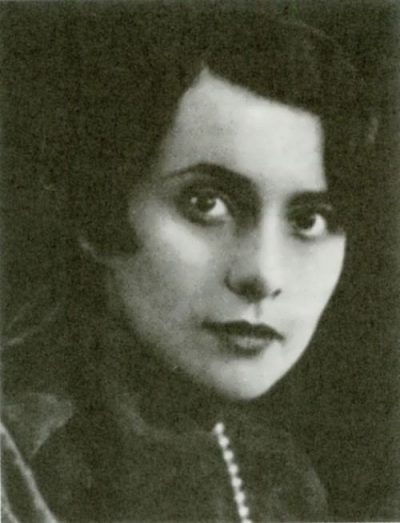tutorial, characters, video, criticism, study resources
Mrs Dalloway (1925) is probably the most accessible of Virginia Woolf’s great modernist novels. A day in the life of a London society hostess is used as the structure for her experiments in multiple points of view. The themes she explores are the nature of personal identity; memory and consciousness; the passage of time; and the tensions between the forces of Life and Death. The novel abandons conventional notions of plot in favour of a mosaic of events.

Virginia Woolf
She gives a very lyrical response to the fundamental question, ‘What is it like to be alive?’ And her answer is a sensuous expression of metropolitan existence. The novel also features her rich expression of ‘interior monologue’ as a narrative technique, and it offers a subtle critique of society recovering in the aftermath of the first world war. This novel is now seen as a central text of English literary modernism.
Mrs Dalloway – plot summary
The novel covers one day from morning to night in a woman’s life – Clarissa Dalloway, an upper-class society wife. As the novel opens she walks through the streets of London in the morning, getting ready to host a party that evening. The pleasant day reminds her of her youth at Bourton and makes her wonder about her choice of husband. She married the reliable Richard Dalloway instead of the enigmatic and demanding Peter Walsh, and she had not the option to be with Sally Seton towards whom she felt a strong attraction. Peter reintroduces these conflicts by paying a visit that morning, having returned from India that day. After his visit, he wanders off into Regent’s Park.
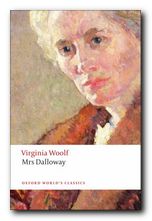 The point of view then shifts to Septimus Warren Smith, a veteran of World War I who is suffering from post traumatic stress (or ‘shell shock’ as it was first known). He is spending his day in the Park with his Italian-born wife, Lucrezia, waiting for an appointment with Sir William Bradshaw, a celebrated psychiatrist. Septimus is visited by frequent and indecipherable hallucinations, mostly concerning his dear friend Evans who died in the war. He cannot see anything of worth in the England he fought for, and he believes his lack of feeling is a crime. However, Sir William does not listen to him and diagnoses ‘a lack of proportion’. He proposes to send Septimus to a mental institution.
The point of view then shifts to Septimus Warren Smith, a veteran of World War I who is suffering from post traumatic stress (or ‘shell shock’ as it was first known). He is spending his day in the Park with his Italian-born wife, Lucrezia, waiting for an appointment with Sir William Bradshaw, a celebrated psychiatrist. Septimus is visited by frequent and indecipherable hallucinations, mostly concerning his dear friend Evans who died in the war. He cannot see anything of worth in the England he fought for, and he believes his lack of feeling is a crime. However, Sir William does not listen to him and diagnoses ‘a lack of proportion’. He proposes to send Septimus to a mental institution.
The scene switches again to conservative MP Richard Dalloway taking lunch with Hugh Whitbread and Lady Bruton, members of high society. After lunch, Richard returns home to Clarissa with a large bunch of roses. He intends to tell her that he loves her but finds that he cannot. Clarissa considers the void that exists between people, even between husband and wife.
Clarissa sees off her daughter Elizabeth and her history teacher, Miss Kilman, who are going shopping. The two older women dislike one another quite passionately, each believing the other to be an oppressive force over Elizabeth. Meanwhile, Septimus and Lucrezia are in their apartment, enjoying a moment of happiness together before the men come to take Septimus to the asylum. One of Septimus’s doctors, Dr. Holmes, arrives, and Septimus fears the doctor will destroy his soul. In order to avoid this fate, he jumps from a window to his death on the railings below.
In the evening, most of the novel’s characters (including people from her past) assemble for Clarissa’s party. It turns out to be a big success, but Clarissa cannot help feeling wistful about her friends and the fact that most of them have not achieved the dreams of their youth. She feels that even her daughter Elizabeth will be the same.
When Sir William Bradshaw arrives late his wife explains that one of his patients has committed suicide. Hearing this, Clarissa gradually identifies with Septimus, and feels that she understands his motives. She retires to reflect on the matter, seeing people such as Sir William Bradshaw antithetical to life, and admiring Septimus for his courage in resisting medical bullying.
The party nears its close, and the guests begin to leave, hereupon Clarissa re-enters the room and fills it with her ‘presence’. This fills Peter Walsh with awe, for despite his criticisms of Clarissa for leadingthe shallow life of a society hostess, he is forced to admit to himself that he admires her.
Video lecture
Part I of biographical documentary
Mrs Dalloway – study resources
![]() Mrs Dalloway – Oxford World Classics – Amazon UK
Mrs Dalloway – Oxford World Classics – Amazon UK
![]() Mrs Dalloway – Oxford World Classics – Amazon US
Mrs Dalloway – Oxford World Classics – Amazon US
![]() Mrs Dalloway – Penguin Classics – Amazon UK
Mrs Dalloway – Penguin Classics – Amazon UK
![]() Mrs Dalloway – Penguin Classics – Amazon US
Mrs Dalloway – Penguin Classics – Amazon US
![]() Mrs Dalloway – Everyman Library Classics – Amazon UK
Mrs Dalloway – Everyman Library Classics – Amazon UK
![]() Mrs Dalloway – Everyman Library Classics – Amazon US
Mrs Dalloway – Everyman Library Classics – Amazon US
![]() Mrs Dalloway – York Notes – Amazon UK
Mrs Dalloway – York Notes – Amazon UK
![]() Mrs Dalloway – Cliffs Notes – Amazon UK
Mrs Dalloway – Cliffs Notes – Amazon UK
![]() Approaches to Teaching Mrs Dalloway – Amazon UK
Approaches to Teaching Mrs Dalloway – Amazon UK
![]() The Cornell Guide to Mrs Dalloway – Amazon UK
The Cornell Guide to Mrs Dalloway – Amazon UK
![]() Mrs Dalloway – free eBook edition
Mrs Dalloway – free eBook edition
![]() Mrs Dalloway – 1998 dramatisation on DVD – Amazon UK
Mrs Dalloway – 1998 dramatisation on DVD – Amazon UK
![]() Mrs Dalloway – a facsimile page from Woolf’s manuscript
Mrs Dalloway – a facsimile page from Woolf’s manuscript
![]() Mrs Dalloway – Virginia Woolf as a Modernist Writer – essay
Mrs Dalloway – Virginia Woolf as a Modernist Writer – essay
![]() Virginia Woolf – biographical notes
Virginia Woolf – biographical notes
![]() The Complete Works of Virginia Woolf – Kindle edition – Amazon UK
The Complete Works of Virginia Woolf – Kindle edition – Amazon UK
![]() The Mrs Dalloway Reader – critical essays – Amazon UK
The Mrs Dalloway Reader – critical essays – Amazon UK
![]() Approaches to Teaching Mrs Dalloway – Amazon UK
Approaches to Teaching Mrs Dalloway – Amazon UK
![]() Selected Essays – by Virginia Woolf – Amazon UK
Selected Essays – by Virginia Woolf – Amazon UK
![]() The Cambridge Companion to Virginia Woolf – Amazon UK
The Cambridge Companion to Virginia Woolf – Amazon UK
![]() Virginia Woolf – Authors in Context – Amazon UK
Virginia Woolf – Authors in Context – Amazon UK
![]() The Cambridge Introduction to Virginia Woolf – Amazon UK
The Cambridge Introduction to Virginia Woolf – Amazon UK
![]() Virginia Woolf at Wikipedia – biographical notes, links
Virginia Woolf at Wikipedia – biographical notes, links
![]() Virginia Woolf at Mantex – tutorials, web links, study materials
Virginia Woolf at Mantex – tutorials, web links, study materials
Photomontage
Mrs Dalloway’s walk – through modern day London
Principal characters
| Richard Dalloway | a conservative Member of Parliament |
| Clarissa Dalloway | his wife – a society hostess |
| Elizabeth Dalloway | their 17 year old daughter |
| Septimus Warren Smith | a shell-shocked WWI veteran |
| Lucrezia Smith | his wife – an Italian millener |
| Peter Walsh | a romantic admirer of Clarissa’s |
| Sally Seaton | childhood close friend of Clarissa’s |
| Hugh Whitbread | a vacuous English gentleman |
| Doris Kilman | born-again Christian, Elizabeth’s teacher |
| Sir William Bradshaw | renowned London psychiatrist |
| Dr Holmes | Septimus’ unimaginative doctor |
| Lady Bruton | society lady and do-gooder |
| Evans | Septimus’s close friend in the war |
Virginia Woolf podcast
A eulogy to words
Further reading
![]() Bell, Quentin. Virginia Woolf: A Biography. New York: Harcourt Brace Jovanovich, 1972.
Bell, Quentin. Virginia Woolf: A Biography. New York: Harcourt Brace Jovanovich, 1972.
![]() Bloom, Harold, ed. Modern Critical Interpretations: Virginia Woolf’s Mrs. Dalloway. New York: Chelsea House, 1988.
Bloom, Harold, ed. Modern Critical Interpretations: Virginia Woolf’s Mrs. Dalloway. New York: Chelsea House, 1988.
![]() Dowling, David. Mrs. Dalloway: Mapping Streams of Consciousness. Boston: Twayne, 1991.
Dowling, David. Mrs. Dalloway: Mapping Streams of Consciousness. Boston: Twayne, 1991.
![]() Lee, Hermione. Virginia Woolf. New York: Alfred A. Knopf, 1997.
Lee, Hermione. Virginia Woolf. New York: Alfred A. Knopf, 1997.
![]() Marsh, Nicholas. Virginia Woolf, the Novels. New York: St. Martin’s Press, 1998.
Marsh, Nicholas. Virginia Woolf, the Novels. New York: St. Martin’s Press, 1998.
![]() Mepham, John. Virginia Woolf. New York: St. Martin’s Press, 1992.
Mepham, John. Virginia Woolf. New York: St. Martin’s Press, 1992.
![]() Reinhold, Natalya, ed. Woolf Across Cultures. New York: Pace University Press, 2004.
Reinhold, Natalya, ed. Woolf Across Cultures. New York: Pace University Press, 2004.
![]() Rosenthal, Michael. Virginia Woolf: A Critical Study. New York: Columbia University Press, 1979.
Rosenthal, Michael. Virginia Woolf: A Critical Study. New York: Columbia University Press, 1979.
![]() Sellers, Susan, The Cambridge Companion to Vit=rginia Woolf, Cambridge University Press, 2010.
Sellers, Susan, The Cambridge Companion to Vit=rginia Woolf, Cambridge University Press, 2010.
![]() Showalter, Elaine. ‘Mrs. Dalloway: Introduction’. In Virginia Woolf: Introductions to the Major Works, edited by Julia Briggs. London: Virago Press, 1994.
Showalter, Elaine. ‘Mrs. Dalloway: Introduction’. In Virginia Woolf: Introductions to the Major Works, edited by Julia Briggs. London: Virago Press, 1994.
![]() Woolf, Virginia. The Common Reader. New York: Harvest Books, 2002.
Woolf, Virginia. The Common Reader. New York: Harvest Books, 2002.
![]() Mrs. Dalloway’s Party: A Short Story Sequence. Edited by Stella McNichol. New York: Harcourt Brace Jovanovich, 1975.
Mrs. Dalloway’s Party: A Short Story Sequence. Edited by Stella McNichol. New York: Harcourt Brace Jovanovich, 1975.
![]() Zwerdling, Alex. Virginia Woolf and the Real World. Berkeley: University of California Press, 1986.
Zwerdling, Alex. Virginia Woolf and the Real World. Berkeley: University of California Press, 1986.
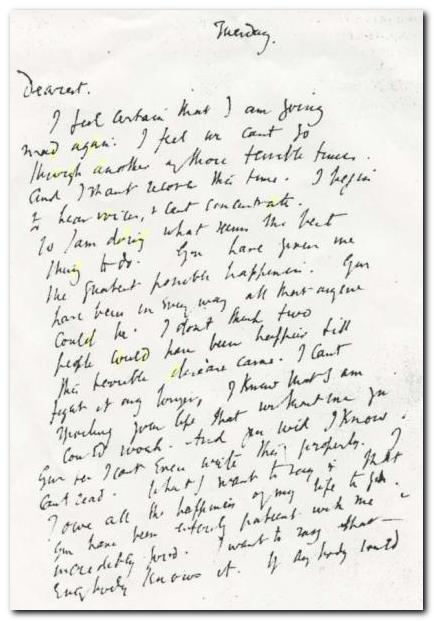
“I feel certain that I am going mad again.”
Mrs Dalloway – first edition
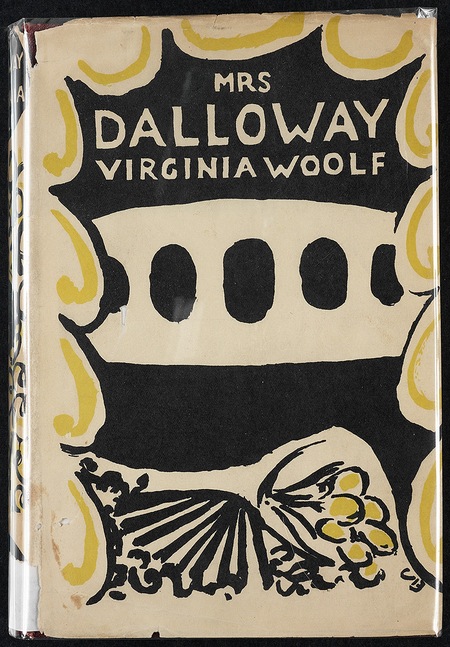
Virginia Woolf, Mrs. Dalloway (1925) Dust jacket designed by Vanessa Bell.
This appeared only a few weeks after the publication of The Common Reader and although the reviews were mixed, the book had sold 2,000 copies by the end of the year.
This is the first of Virginia Woolf’s three great masterpieces (along with To the Lighthouse and The Waves. In it, she developed the experimental literary techniques which had been tried out in Jacob’s Room and brought them to an achievement of a high order.
“The reviews when they came were mixed, and so was Bloomsbury’s reaction. E.M. Forseter praised Mrs Dalloway and Virginia, gallantly kissing her hand and telling her the novel was better than Jacob’s Room and he was very pleased; but Vita Sackville-West was doubtful; and Lytton Strachey, admiring The Common Reader more, thought the novel was a flawed stone. Readers bought the book, however, and the sales were brisk. By June 18, one month after publication, Virginia noted that 1,250 copies had been sold … Leonard issued a second impression of 1,000 copies in November 1925.”
J.H. Willis Jr, Leonard and Virginia Woolf as Publishers: The Hogarth Press 1917-1941
Vanessa Bell’s design for the jacket of the novel features a bouquet of flowers. Diane Gillespie notes that the “design in which first the white, then the black dominates, the cover anticipates, if only in a general way, the alternating exhilaration and fear, sanity and insanity, as well as life and death which pervade the book”.
Elizabeth Willson Gordon, Woolf’s-head Publishing: The Highlights and New Lights of the Hogarth Press

Mont Blanc pen – the Virginia Woolf special edition
Other works by Virginia Woolf
 To the Lighthouse (1927) is the second of the twin jewels in the crown of her late experimental phase. It is concerned with the passage of time, the nature of human consciousness, and the process of artistic creativity. Woolf substitutes symbolism and poetic prose for any notion of plot, and the novel is composed as a tryptich of three almost static scenes – during the second of which the principal character Mrs Ramsay dies – literally within a parenthesis. The writing is lyrical and philosophical at the same time. Many critics see this as her greatest achievement, and Woolf herself realised that with this book she was taking the novel form into hitherto unknown territory.
To the Lighthouse (1927) is the second of the twin jewels in the crown of her late experimental phase. It is concerned with the passage of time, the nature of human consciousness, and the process of artistic creativity. Woolf substitutes symbolism and poetic prose for any notion of plot, and the novel is composed as a tryptich of three almost static scenes – during the second of which the principal character Mrs Ramsay dies – literally within a parenthesis. The writing is lyrical and philosophical at the same time. Many critics see this as her greatest achievement, and Woolf herself realised that with this book she was taking the novel form into hitherto unknown territory.
![]() Buy the book at Amazon UK
Buy the book at Amazon UK
![]() Buy the book at Amazon US
Buy the book at Amazon US
 Orlando (1928) is one of her lesser-known novels, although it’s critical reputation has risen in recent years. It’s a delightful fantasy which features a character who changes sex part-way through the book – and lives from the sixteenth to the twentieth century. Using this device (which turns out to be strangely credible) Woolf explores issues of gender and identity as her hero-heroine moves through a variety of lives and personal adventures. Orlando starts out as an emissary to the Court of St James, lives through friendships with Swift and Alexander Pope, and ends up motoring through the west end of London on a shopping expedition in the 1920s. The character is loosely based on Vita Sackville-West, who at one time was Woolf’s lover. The novel itself was described by Nigel Nicolson (Sackville-West’s son) as ‘the longest and most charming love-letter in literature’.
Orlando (1928) is one of her lesser-known novels, although it’s critical reputation has risen in recent years. It’s a delightful fantasy which features a character who changes sex part-way through the book – and lives from the sixteenth to the twentieth century. Using this device (which turns out to be strangely credible) Woolf explores issues of gender and identity as her hero-heroine moves through a variety of lives and personal adventures. Orlando starts out as an emissary to the Court of St James, lives through friendships with Swift and Alexander Pope, and ends up motoring through the west end of London on a shopping expedition in the 1920s. The character is loosely based on Vita Sackville-West, who at one time was Woolf’s lover. The novel itself was described by Nigel Nicolson (Sackville-West’s son) as ‘the longest and most charming love-letter in literature’.
![]() Buy the book at Amazon UK
Buy the book at Amazon UK
![]() Buy the book at Amazon US
Buy the book at Amazon US
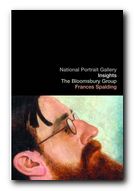 The Bloomsbury Group is a short but charming book, published by the National Portrait Gallery. It explores the impact of Bloomsbury personalities on each other, plus how they shaped the development of British modernism in the early part of the twentieth century. But most of all it’s a delightful collection of portrait paintings and photographs, with biographical notes. It has an introductory essay which outlines the development of Bloomsbury, followed by a series of portraits and the biographical sketches of the major figures.
The Bloomsbury Group is a short but charming book, published by the National Portrait Gallery. It explores the impact of Bloomsbury personalities on each other, plus how they shaped the development of British modernism in the early part of the twentieth century. But most of all it’s a delightful collection of portrait paintings and photographs, with biographical notes. It has an introductory essay which outlines the development of Bloomsbury, followed by a series of portraits and the biographical sketches of the major figures.
![]() Buy the book at Amazon UK
Buy the book at Amazon UK
![]() Buy the book at Amazon US
Buy the book at Amazon US
Virginia Woolf – web links
![]() Virginia Woolf at Mantex
Virginia Woolf at Mantex
Biographical notes, study guides to the major works, book reviews, studies of the short stories, bibliographies, web links, study resources.
![]() Blogging Woolf
Blogging Woolf
Book reviews, Bloomsbury related issues, links, study resources, news of conferences, exhibitions, and events, regularly updated.
![]() Virginia Woolf at Wikipedia
Virginia Woolf at Wikipedia
Full biography, social background, interpretation of her work, fiction and non-fiction publications, photograph albumns, list of biographies, and external web links
![]() Virginia Woolf at Gutenberg
Virginia Woolf at Gutenberg
Selected eTexts of the novels The Voyage Out, Night and Day, Jacob’s Room, and the collection of stories Monday or Tuesday in a variety of digital formats.
![]() Woolf Online
Woolf Online
An electronic edition and commentary on To the Lighthouse with notes on its composition, revisions, and printing – plus relevant extracts from the diaries, essays, and letters.
![]() Hyper-Concordance to Virginia Woolf
Hyper-Concordance to Virginia Woolf
Search texts of all the major novels and essays, word by word – locate quotations, references, and individual terms
![]() Virginia Woolf – a timeline in phtographs
Virginia Woolf – a timeline in phtographs
A collection of well and lesser-known photographs documenting Woolf’s life from early childhood, through youth, marriage, and fame – plus some first edition book jackets – to a soundtrack by Philip Glass. They capture her elegant appearance, the big hats, and her obsessive smoking. No captions or dates, but well worth watching.
![]() Women’s History Walk in Bloomsbury
Women’s History Walk in Bloomsbury
Tour of literary and political homes in Bloomsbury – including Gordon Square, Gower Street, Bedford Square, Tavistock Square, plus links to women’s history web sites.
![]() Virginia Woolf Society of Great Britain
Virginia Woolf Society of Great Britain
Bulletins of events, annual lectures, society publications, and extensive links to Woolf and Bloomsbury related web sites
![]() BBC Audio Essay – A Eulogy to Words
BBC Audio Essay – A Eulogy to Words
Charming sound recording of radio talk given by Virginia Woolf in 1937 – a podcast accompanied by a slideshow of photographs.
![]() A Family Photograph Albumn
A Family Photograph Albumn
Leslie Stephen compiled a photograph album and wrote an epistolary memoir, known as the “Mausoleum Book,” to mourn the death of his wife, Julia, in 1895 – an archive at Smith College – Massachusetts
![]() Virginia Woolf first editions
Virginia Woolf first editions
Hogarth Press book jacket covers of the first editions of Woolf’s novels, essays, and stories – largely designed by her sister, Vanessa Bell.
![]() Virginia Woolf – on video
Virginia Woolf – on video
Biographical studies and documentary videos with comments on Virginia Woolf and the Bloomsbury Group and the social background of their times.
![]() Virginia Woolf Miscellany
Virginia Woolf Miscellany
An archive of academic journal essays 2003—2014, featuring news items, book reviews, and full length studies.
© Roy Johnson 2010
More on Virginia Woolf
Virginia Woolf – web links
Virginia Woolf – greatest works
Virginia Woolf – criticism
More on the Bloomsbury Group
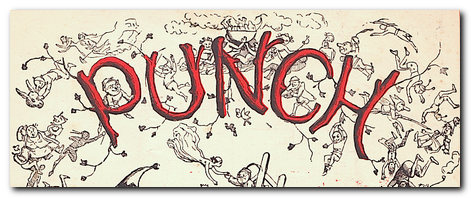


 The Aspern Papers
The Aspern Papers The Spoils of Poynton
The Spoils of Poynton Daisy Miller
Daisy Miller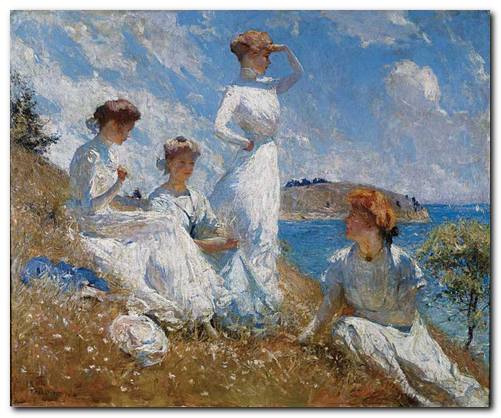
 Washington Square
Washington Square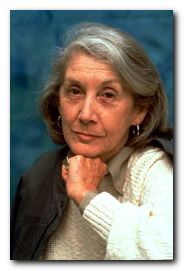 Nadine Gordimer (1923—2014) was born into a privileged white middle-class family in the Transvaal, South Africa. She began reading at an early age, and published her first story in a magazine when she was only fifteen. Her wide reading informed her about the world on the other side of apartheid – the official South African policy of racial segregation – and that discovery in time developed into strong political opposition to apartheid. She attended the University of Witwatersrand for one year. Her first book was a collection of short stories, The Soft Voice of the Serpent (1952). In addition to writing, she lectured and taught at various schools in the United States during the 1960s and 1970s. She was awarded the Nobel prize for Literature in 1991.
Nadine Gordimer (1923—2014) was born into a privileged white middle-class family in the Transvaal, South Africa. She began reading at an early age, and published her first story in a magazine when she was only fifteen. Her wide reading informed her about the world on the other side of apartheid – the official South African policy of racial segregation – and that discovery in time developed into strong political opposition to apartheid. She attended the University of Witwatersrand for one year. Her first book was a collection of short stories, The Soft Voice of the Serpent (1952). In addition to writing, she lectured and taught at various schools in the United States during the 1960s and 1970s. She was awarded the Nobel prize for Literature in 1991. The Conservationist (1974) concerns a white industrialist who farms his land (with native help) at the weekend and genuinely wants to make his presence a positive contribution. But most of all he wants to preserve his power and his privileged way of life – despite being surrounded by poverty and suffering. He just doesn’t understand that the indigenous population are the natural owners of the land, and the result is disastrous – for him.
The Conservationist (1974) concerns a white industrialist who farms his land (with native help) at the weekend and genuinely wants to make his presence a positive contribution. But most of all he wants to preserve his power and his privileged way of life – despite being surrounded by poverty and suffering. He just doesn’t understand that the indigenous population are the natural owners of the land, and the result is disastrous – for him.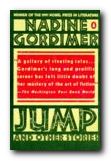 Jump Her development as a writer of short stories is wonderful. She starts off in modern post-Checkhovian mode presenting situations which have little drama but which invite the reader to contemplate states of being or moods which illustrate the ideologies of South Africa. Technically, Nadine Gordimer experiments heavily with point of view, narrative perspective, unexplained incidents, switches between internal monologue and third person narrative (rather like Virginia Woolf) and a heavy use of ‘as if’ prose where narrator-author boundaries become very blurred.
Jump Her development as a writer of short stories is wonderful. She starts off in modern post-Checkhovian mode presenting situations which have little drama but which invite the reader to contemplate states of being or moods which illustrate the ideologies of South Africa. Technically, Nadine Gordimer experiments heavily with point of view, narrative perspective, unexplained incidents, switches between internal monologue and third person narrative (rather like Virginia Woolf) and a heavy use of ‘as if’ prose where narrator-author boundaries become very blurred. Selected Stories As her work matured, her style and methods underwent a similar development to those of Virginia Woolf. Some of her stories became more lyrical, more compacted and symbolic, abandoning any semblance of conventional story or plot in favour of a poetic meditation on a theme. There are some stories which make enormous demands upon the reader. Sometimes on first reading it’s even hard to know what is going on. But gradually a densely concentrated image or an idea will emerge – the equivalent of a Joycean ‘epiphany’ – and everything falls into place. Her own collection of Selected Stories are UK National Curriculum recommended reading.
Selected Stories As her work matured, her style and methods underwent a similar development to those of Virginia Woolf. Some of her stories became more lyrical, more compacted and symbolic, abandoning any semblance of conventional story or plot in favour of a poetic meditation on a theme. There are some stories which make enormous demands upon the reader. Sometimes on first reading it’s even hard to know what is going on. But gradually a densely concentrated image or an idea will emerge – the equivalent of a Joycean ‘epiphany’ – and everything falls into place. Her own collection of Selected Stories are UK National Curriculum recommended reading.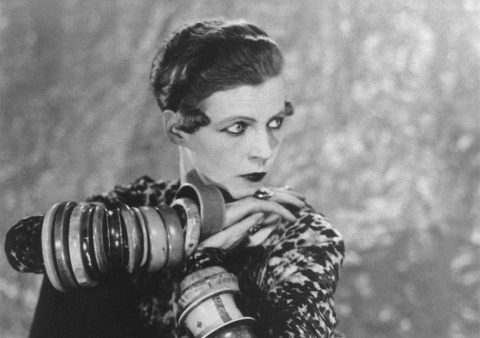


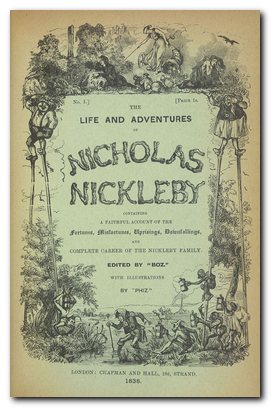
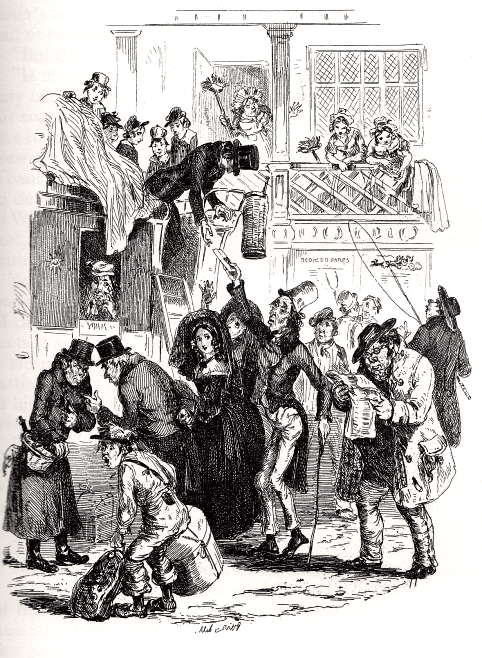

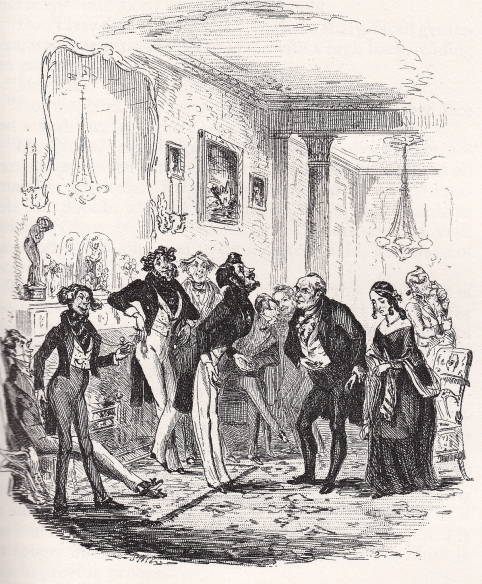
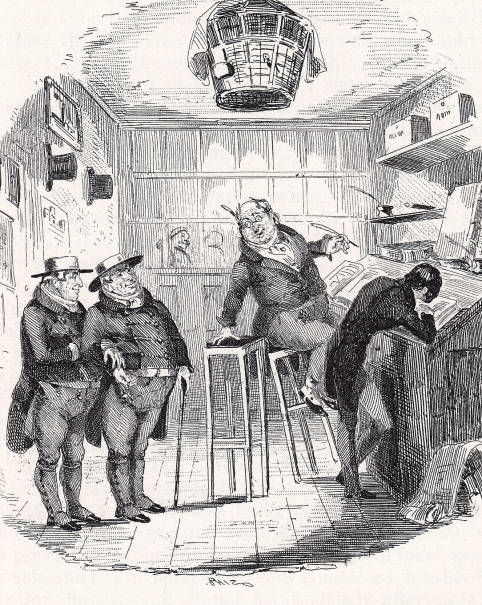

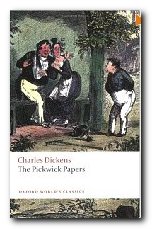 Pickwick Papers (1836-37) was Dickens’ first big success. It was issued in twenty monthly parts and is not so much a novel as a series of loosely linked sketches and changing characters featured in reports to the Pickwick Club. These recount comic excursions to Rochester, Dingley Dell, and Bath; duels and elopements; Christmas festivities; Mr Pickwick inadvertently entering the bedroom of a middle-aged lady at night; and in the end a happy marriage. Much light-hearted fun, and a host of memorable characters.
Pickwick Papers (1836-37) was Dickens’ first big success. It was issued in twenty monthly parts and is not so much a novel as a series of loosely linked sketches and changing characters featured in reports to the Pickwick Club. These recount comic excursions to Rochester, Dingley Dell, and Bath; duels and elopements; Christmas festivities; Mr Pickwick inadvertently entering the bedroom of a middle-aged lady at night; and in the end a happy marriage. Much light-hearted fun, and a host of memorable characters.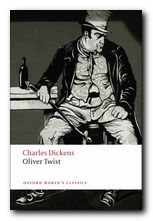 Oliver Twist (1837-38) expresses Dickens’ sense of the vulnerability of children. Oliver is a foundling, raised in a workhouse, who escapes suffering by running off to London. There he falls into the hands of a gang of thieves controlled by the infamous Fagin. He is pursued by the sinister figure of Monks who has secret information about him. The plot centres on the twin issues of personal identity and a secret inheritance (which surface again in Great Expectations). Emigration, prison, and violent death punctuate a cascade of dramatic events. This is the early Victorian novel in fine melodramatic form. Recommended for beginners to Dickens.
Oliver Twist (1837-38) expresses Dickens’ sense of the vulnerability of children. Oliver is a foundling, raised in a workhouse, who escapes suffering by running off to London. There he falls into the hands of a gang of thieves controlled by the infamous Fagin. He is pursued by the sinister figure of Monks who has secret information about him. The plot centres on the twin issues of personal identity and a secret inheritance (which surface again in Great Expectations). Emigration, prison, and violent death punctuate a cascade of dramatic events. This is the early Victorian novel in fine melodramatic form. Recommended for beginners to Dickens.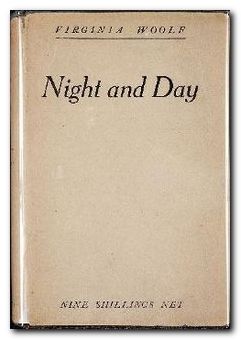

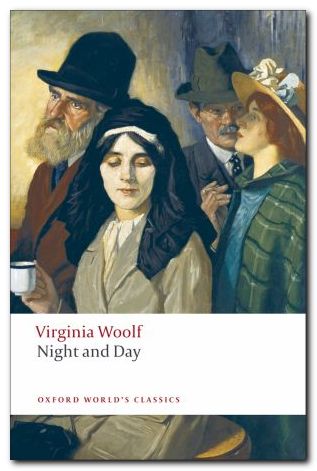
 Kew Gardens
Kew Gardens Virginia Woolf
Virginia Woolf
